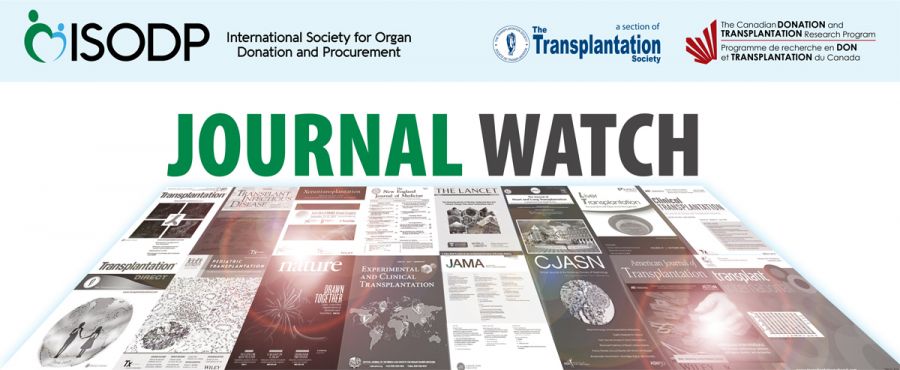Introduction
Greetings again from Canada, where summer is finally upon us. We have spent the last bit of spring collecting another group of articles that we feel would be valuable to the worldwide donation community. This edition of the Journal Watch focuses mainly on aspects of system development, from how to measure and compare performance metrics to what are the signs of work-related issues we should be monitoring for in donor coordinators. There is an analysis of how even similarly structured systems in the UK and Australia can be very difficult to compare using currently collected data. There is also a report from an international round table exploring how donation after voluntary euthanasia (also known as medical assistance in dying) has been integrated into end-of-life care in a few countries, a description of DCD protocol variations in the area covered by an organ donation organization in the United States, and others.
We congratulate the authors who continue to advance the science of how best to structure a donation system and of course a special thanks to Amina Silva and Sylvia Okonofua who helped us identify and summarize these articles. Please share broadly with your organ donation community and send any articles you think might be of interest for future inclusion to the address below.
We hope that whether summer or winter is heading your way, you enjoy the upcoming season, and we will be back again with another edition in September.
Sincerely,
Sonny Dhanani
(Associate Director, CDTRP and Chair of the Canadian Donation Physician Network)
sdhanani@cheo.on.ca
Matthew Weiss
(Medical Director - Organ Donation at Transplant Québec and National Lead of the LEADDR Research Program, CDTRP)
matthew.weiss.med@ssss.gouv.qc.ca

Comparing Deceased Organ Donation Performance in Two Countries Use Different Metrics: Comparing Apples with Apples
Milross, L., Brown, C., Gladkis, L. et al.
Transplantation International, May 13, 2022
Corresponding author: luke.milross@health.nsw.gov.au
Milross et al. performed a comprehensive comparison of similar metrics between two advanced organ donation systems. Identifying appropriate rates leading to conversion of a potential donor are useful for systems developing best practices. Despite uniform definitions having been created over a decade ago, metrics differed between the UK and Australia. What definitions were used, how and when data was collected, and relationships between data points also differed. Non-uniform metrics made comparisons and interpretations difficult. Authors propose recommendations that would move toward a shared “international language” that allow for meaningful comparisons in the future.

Variation in donation after circulatory death hospital policies in a single donor service area
Wall, A. E., Shabbir, R., Chebrolu, S. et al.
The American Journal of Surgery, 2022
Corresponding author: Anji.Wall@bswhealth.org
This paper is a content analysis of donation after circulatory death (DCD) policies from hospitals covered by a large organ donation organization (ODO) in the Southwest United States. The group led by Dr. Wall and colleagues discovered that even within this geographic area covered by a single ODO there was substantial variability in the 98 documents reviewed. Importantly, this included the duration of time for the hands-off period, with 28% of centers recommending a two-minute hands-off time before determination of death and 60% with a 5- minute hands-off time. The authors note that while there has been increased homogeneity of DCD policies since similar surveys in 2011, there is substantial room for increased congruence between national recommendations and local hospital policies. This inconsistency, however, was noted by the authors to be at least partially explained by the fact that within the US different national groups have differing recommendations regarding aspects of DCD.

Burnout, compassion fatigue and work-related stressors among organ donation and transplantation coordinators: A qualitative study
e Silva, V. S., Hornby, L., Lotherington, K. et al.
Intensive and Critical Care Nursing, February 2022
Corresponding author: vsilvaesilva@brocku.ca
The qualitative descriptive study led by Dr. Silva e Silva et al. investigated the experiences and perceptions of organ and tissue donation coordinators pertaining to compassion fatigue, burnout, and resilience as it relates to their daily work. This small sample of Canadian coordinators reported that their work involves a multi-phased process, including difficult and unpredictable cases, and institutional issues. The constant exposure to stressors, grief and emotionally charged situations led many of the participants to experience signs and symptoms of burnout and compassion fatigue throughout their careers, including the presence of sleep deprivation, nightmares, and changes in humor. Despite all challenges, participants reported that aspects such as resilience and peer support from other coordinators can positively impact their ability to manage work-related stressors. Still, these coordinators recognized the need for more strategies to help mitigate work-related issues and they believe that those initiatives should be led by management and institutions with the ultimate goal of supporting their work-related wellbeing and their ability to optimize organ donation processes.

The first international roundtable on “organ donation after circulatory death by medical assistance in dying” demonstrates increasing incidence of successful patient-driven procedure
Mulder J., Sonneveld H., Healey A. & Van Raemdonck D.
American Journal of Transplantation, October 27, 2021
Corresponding author: vj.g.h.mulder@isala.nl
The letter to the editor written by Mulder et al. reports on the outcomes of the first international roundtable on organ donation after medical assistance in dying (MAiD), which happened during the 26th WONCA (world conference of family doctors) in the Netherlands. The discussion had 16 euthanasia and/or organ donation experts from eight countries (The Netherlands, Belgium, Luxembourg, Canada, Australia, Spain, New Zealand and Colombia). Although MAiD, also known as euthanasia, has been performed 17261 times across these eight countries in 2020, reportedly only 41 of those cases involved organ donation (all from Canada, Belgium and The Netherlands, which were the only countries that allowed for that dual procedure at the time). Organ donation following MAiD can be a source for organ donation and studies have demonstrated that kidneys, lungs and livers transplants from MAiD donors have suitable outcomes for recipients. Additionally, to improve the end-of-life care for MAiD donors, some countries started performing organ donation following MAiD at home (which may include initiating the dying process at home or hospital setting). This dual procedure has been reported only five times, and despite the controversial discussions around this topic, there was an agreement that development of donation after MAiD at home must remain a priority in the MAiD-patient-caredriven process.

Evaluating Organ Donation Decision in ICU Patients’ Families by Analytic Network Process Approach
Lo, C.-L., Chang, H.-Y., & Lee, G.-M.
Journal of Healthcare Engineering, April 15, 2022
Corresponding author: allenlo.tw@gmail.com
This article from Lo et al. examines the seldom mentioned aspect of organ donation post-mortem: the legal rights family members have over the patient’s remains by refusing the patient’s consent before death. The authors used the Analytic Network Process (ANP) to highlight prioritization factors contributing to the family’s willingness or unwillingness to donate organs of intensive care unit patients. This study enrolled 80 patient’s families from five intensive care units in Taiwan. The analysis of the ANP showed that when family members of patients made organ donation decisions, it was based on four domains: psychology (47.6%), externality (20.3%), spirituality (19.7%), and physiology (12.3%). The main factors contributing to the above weighting were found to be: “attitude” (31.5%), “physician’s experience” (0.88%), “religion” (19.3%), and “organ selection” (31.9%). Interestingly, the results also indicated that educational attainment, whether the patient had signed an organ donor card, and attitude toward organ donation were significantly correlated with families’ consent to organ donation. However, it is worth noting that all the opinions about organ donation and relative importance were obtained from the questionnaire, and the research results were greatly dependent on the relative knowledge and experience of the patients’ families.

Tackling organ donation among minority ethnic communities in the UK - a whole systems approach
Randhawa, G., & Gardiner, D.
British Medical Bulletin, April 3, 2022
Corresponding author: gurch.randhawa@beds.ac.uk
This study identified inequalities in transplant services affecting minority ethnic groups in the UK. They proposed four core areas in transplantation that require culturally competent approaches if a vision of equity and inclusion in transplantation is to be realized, which are: transplant services, workforce and staff training, diversity and inclusion research, and public engagement. The solutions to rectifying this situation require a holistic approach that considers both the short-term requirement to increase the number of organ donors from minority ethnic groups, and the long-term focus to decrease the number of minority ethnic patients requiring a transplant through preventative strategies.
Social
Contact
Address
International Society for Organ
Donation Professionals
c/o The Transplantation Society
740 Notre-Dame Ouest
Suite 1245
Montréal, QC, H3C 3X6
Canada



